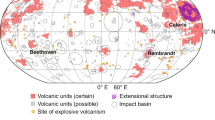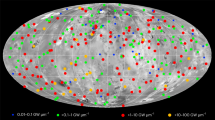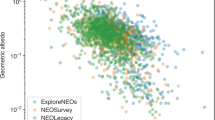Abstract
The myriad bodies that occur in the Solar System have a wide range of properties, from giant gaseous planets such as Jupiter to small, solid, rocky satellites such as our Moon. Exploration by spacecraft during the past four decades has shown that volcanism — an important mechanism by which internal heat is transported to the surface — is common on many of these bodies. There are many common traits; for example, relatively quiet eruptions of molten rock occur on such diverse bodies as the Earth, Mars and Jupiter's moon Io. The volcanic constructs produced, however, vary strikingly, and range from Olympus Mons on Mars, at over 20 km high, to relatively tiny cones on Earth no more than a few tens of metres high. The recognition of icy volcanoes spewing water or organic liquids on some of Saturn's moons constitutes one of the most exciting results to emerge from recent space missions.
This is a preview of subscription content, access via your institution
Access options
Subscribe to this journal
Receive 12 print issues and online access
$259.00 per year
only $21.58 per issue
Buy this article
- Purchase on Springer Link
- Instant access to full article PDF
Prices may be subject to local taxes which are calculated during checkout





Similar content being viewed by others
References
McKinnon, W. B., Kahnle, K. J., Ivanov, B. A. & Melosh, H. J. in Venus II: Geology, Geophysics, Atmosphere, and Solar Wind Experiment. (eds Bougher, S. W., Hunten, D. M. & Phillips, R. J.) 1047–1086 (Univ. Arizona Press, 1997).
Neukum, G. et al. Recent and episodic volcanic and glacial activity on Mars revealed by the High Resolution Stereo Camera. Nature 432, 971–979 (2004).
Johnson, T. V., Cook, A. F., Sagan, C. & Soderblom, L. A. Volcanic resurfacing rates and implications for volatiles on Io. Nature 280, 746–750 (1979).
Hiesinger, H., Head, J. W., Wolf, U., Jaumann, R. & Neukum, G. Ages and stratigraphy of mare basalts in Oceanus Procellarum, Mare Nubium, Mare Cognitum, and Mare Insularum. J. Geophys. Res. 108, 5065 (2003).
Head, J. W. et al. Volcanism on Mercury: Evidence from the first MESSENGER flyby. Science 321, 69–72 (2008).
Breuer, D., Hauck, S. A., Buske, M., Pauer, M. & Spohn, T. Interior evolution of Mercury. Space Sci. Rev. 132, 229–260 (2007).
Stevenson, D. J. Styles of mantle convection and their influence on planetary evolution. C. R. Geosci. 335, 99–111 (2003).
Porco, C. C. et al. Cassini observes the active South Pole of Enceladus. Science 311, 1393–1401 (2006).
Lopes, R. M. C. et al. Cryovolcanic features on Titan's surface as revealed by the Cassini Titan Radar Mapper. Icarus 186, 395–412 (2007).
Mitri, G., Showman, A. P., Lunine, J. I. & Lopes, R. M. C. Resurfacing of Titan by ammonia–water cryomagma. Icarus 196, 216–224 (2008).
Burch, J. L. et al. Tethys and Dione as sources of outward-flowing plasma in Saturn's magnetosphere. Nature 447, 833–835 (2007).
Kargel, J. S. Cryovolcanism on the icy satellites. Earth Moon Planets 67, 101–113 (1995).
Fagents, S. A. Considerations for effusive cryovolcanism on Europa: the post-Galileo perspective. J. Geophys. Res. 108, 5139 (2003).
Showman, A. P., Mosqueira, I. & Head, J. W. On the resurfacing of Ganymede by liquid-water volcanism. Icarus 172, 625–640 (2004).
Ernst, R. E. & Desnoyers, D. W. Lessons from Venus for understanding mantle plumes on Earth. Phys. Earth Planet. Int. 146, 195–229 (2004).
Mège, D. & Masson, P. A plume tectonics model for the Tharsis province, Mars. Planet. Space Sci. 44, 1499–1546 (1996).
Schenk, P. M., Wilson, R. R. & Davies, A. G. Shield volcano topography and the rheology of lava flows on Io. Icarus 169, 98–110 (2004).
Head, J. W. & Wilson, L. Lunar mare volcanism: stratigraphy, eruption conditions, and the evolution of secondary crusts. Geochim. Cosmochim. Acta 56, 2155–2175 (1992).
O'Neill, C., Jellinek, A. M. & Lenardic, A. Conditions for the onset of plate tectonics on terrestrial planets and moons. Earth Planet. Sci. Lett. 261, 20–32 (2007).
Shearer, C. K. et al. New views of the Moon. Rev. Mineral. Geochem. 60, 365–518 (2006).
Treiman, A. H., Gleason, J. D. & Bogard, D. D. The SNC meteorites are from Mars. Planet. Space Sci. 48, 1213–1230 (2000).
Bell, J. (ed.) The Martian Surface. Composition, Mineralogy, and Physical Properties (Cambridge Univ. Press, 2008).
Surkov, Y. A., Barsukov, V. L., Moskalyeva, L. P., Kharyukova, V. P. & Kemurdzhian, A. L. New data on the composition, structure, and properties of Venus rock obtained by Venera 13 and Venera 14. J. Geophys. Res. 89, B393–B402 (1984).
Solomon, S. C. et al. Return to Mercury: A global perspective on MESSENGER's first Mercury flyby. Science 321, 59–62 (2008).
Kesthelyi, L. et al. New estimates for Io eruption temperatures: Implications for the interior. Icarus 192, 491–502 (2007).
Taylor, G. J., Keil, K., McCoy, T., Haack, H. & Scott, E. R. D. Asteroid differentiation: Pyroclastic volcanism to magma oceans. Meteoritics 28, 34–52 (1993).
Fortes, A. D., Grindrod, P. M., Trickett, S. K. & Vocadlo, L. Ammonium sulfate on Titan: Possible origin and role in cryovolcanism. Icarus 188, 139–153 (2007).
Duxbury, N. S. & Brown, R. H. The role of an internal heat source for the eruptive plumes on Triton. Icarus 125, 83–93 (1997).
Roberts, J. H. & Nimmo, F. Near-surface heating on Enceladus and the south polar thermal anomaly. Geophys. Res. Lett. 35, L09201 (2008).
Elkins-Tanton, L. T., Smrekar, S. E., Hess, P. C. & Parmentier, E. M. Volcanism and volatile recycling on a one-plate planet: Applications to Venus. J. Geophys. Res. 112, E04S06 (2007).
Khan, A. & Connolly, J. A. D. Constraining the composition and thermal state of Mars from inversion of geophysical data. J. Geophys. Res. 113, E07003 (2008).
Rubin, A. M. Dikes vs. diapirs in viscoelastic rock. Earth Planet. Sci. Lett. 119, 641–659 (1993).
Mouginis-Mark, P. J. & Rowland, S. K. The geomorphology of planetary calderas. Geomorphology 37, 201–233 (2001).
Radebaugh, J. et al. Paterae on Io: A new type of volcanic caldera? J. Geophys. Res. 106, 33005–33020 (2001).
Kerber, L. et al. Explosive volcanic eruptions on Mercury: Eruption conditions, magma volatile content, and implications for mantle volatile abundances. Earth Planet. Sci. Lett. (in the press).
Zuber, M. T. & Mouginis-Mark, P. J. Caldera subsidence and magma chamber depth of the Olympus Mons volcano, Mars. J. Geophys. Res. 97, 18295–18307 (1992).
Wilson, L. & Head, J. W. Mars: Review and analysis of volcanic eruption theory and relationships to observed landforms. Rev. Geophys. 32, 221–264 (1994).
Leone, G. & Wilson, L. The density structure of Io and the migration of magma through its lithosphere. J. Geophys. Res. 106, 32983–32995 (2001).
Stofan, E. R., Guest, J. E. & Copp, D. L. Development of large volcanoes on Venus: Constraints from Sif, Gula, and Kunapipi Montes. Icarus 152, 75–95 (2001).
Head, J. W. & Wilson, L. Magma reservoirs and neutral buoyancy zones on Venus: Implications for the formation and evolution of volcanic landforms. J. Geophys. Res. 97, 3877–3903 (1992).
Ernst, R. E., Grosfils, E. B. & Mege, D. Giant dike swarms: Earth, Venus and Mars. Annu. Rev. Earth Planet. Sci. 29, 489–534 (2001).
Wilson, L. & Head, J. W. Lateral dike injection and magma eruption around novae and coronae on Venus. 37th Lunar Planet. Sci. Conf. Abstr. 1125 (Lunar and Planetary Inst., Houston, 2006).
Wilson, L. & Head, J. W. Tharsis-radial graben systems as the surface manifestation of plume-related dike intrusion complexes: models and implications. J. Geophys. Res. 107, 5057 (2002).
Wilson, L. & Mouginis-Mark, P. J. Phreatomagmatic explosive activity at Hrad Vallis, Mars. J. Geophys. Res. 108, 5082 (2003).
Wilson, L. & Head, J. W. Evidence for a massive phreatomagmatic eruption in the initial stages of formation of the Mangala Valles outflow channel, Mars. Geophys. Res. Lett. 31, L15701 (2004).
Jaeger, W. L., Keszthelyi, L. P., McEwen, A. S., Dundas, C. M. & Russell, P. S. Athabasca Valles, Mars: A lava-draped channel system. Science 317, 1709–1711 (2007).
Burr, D. M., Wilson, L. & Bargery, A. S. in Megaflooding on Earth and Mars (Cambridge Univ. Press, 2009).
Mouginis-Mark, P. J. & Yoshioka, M. T. The long lava flows of Elysium Planita, Mars. J. Geophys. Res. 103, 19389–19400 (1998).
Davies, A. G. et al. The heartbeat of the volcano: The discovery of episodic activity at Prometheus on Io. Icarus 184, 460–477 (2006).
Glaze, L. S., Baloga, S. M. & Stofan, E. R. A methodology for constraining lava flow rheologies with MOLA. Icarus 165, 26–33 (2003).
Hulme, G. The interpretation of lava flow morphology. Geophys. J. Roy. Astron. Soc. 39, 361–383 (1974).
Self, S., Thordarson, T. & Keszthelyi, L. in Large Igneous Provinces: Continental, Oceanic, and Planetary Flood Volcanism (eds Mahoney, J. J. & Coffin, M. F.) 381–410 (Geophysical Monograph Series 100, American Geophysical Union, 1997).
Magee, K. P., Head, J. W., Ernst, R. E. & Buchan, K. L. Large flow fields on Venus: Implications for plumes, rift association and resurfacing. Geol. Soc. Am. Spec. Pap. 352, 81–101 (2001).
Byrnes, J. M. & Crown, D. A. Morphology, stratigraphy, and surface roughness properties of Venusian lava flow fields. J. Geophys. Res. 107, 5079 (2002).
Basilevskaya, E. A. & Neukum, G. The Olympus volcano on Mars: Geometry and characteristics of lava flows. Solar System Res. 40, 375–383 (2006).
Garry, W. B., Zimbelman, J. R. & Gregg, T. K. P. Morphology and emplacement of a long channelled lava flow near Ascraeus Mons Volcano, Mars. J. Geophys. Res. 112, E08007 (2007).
Hiesinger, H., Head, J. W. & Neukum, G. Young lava flows on the eastern flank of Ascraeus Mons: Rheological properties derived from High Resolution Stereo Camera (HRSC) images and Mars Orbiter Laser Altimeter (MOLA) data. J. Geophys. Res. 112, E05011 (2007).
Wilson, L. & Head, J. W. Volcanism on Mercury: A new model for the history of magma ascent and eruption. Geophys. Res. Lett. 35, L23205 (2008).
Hiesinger, H., Head, J. W., Wolf, U., Jaumann, R. & Neukum, G. Lunar mare basalt flow units: Thicknesses determined from crater size-frequency distributions. Geophys. Res. Lett. 29, 1248 (2002).
Wilson, L., Mouginis-Mark, P. J., Tyson, S., Mackown, J. & Garbeil, H. Fissure eruptions in Tharsis, Mars: Implications for eruption conditions and magma sources. J. Volcanol. Geotherm. Res. 10.1016/j.jvolgeores.2009.03.006 (2009).
Williams, D. A., Davies, A. G., Keszthelyi, L. P. & Greeley, R. The summer 1997 eruption at Pillan Patera on Io: Implications for ultrabasic lava flow emplacement. J. Geophys. Res. 106, 33105–33119 (2001).
Davies, A. G. Volcanism on Io: Estimation of eruption parameters from Galileo NIMS data. J. Geophys. Res. 108, 5106 (2003).
Pavri, B., Head, J. W., Klose, K. B. & Wilson, L. Steep-sided domes on Venus: Characteristics, geologic setting, and eruption conditions from Magellan data. J. Geophys. Res. 97, 13445–13478 (1992).
Petford, N. Dyke widths and ascent rates of silicic magmas on Venus. Trans. R. Soc. Edinb. 91, 87–95 (2000).
Stofan, E. R., Anderson, S. W., Crown, D. A. & Plaut, J. J. Emplacement and composition of steep-sided domes on Venus. J. Geophys. Res. 105, 26757–26771 (2000).
Plaut, J. J., Anderson, S. W., Crown, D. A., Stofan, E. R. & van Zyl, J. J. The unique radar properties of silicic lava domes. J. Geophys. Res. 109, E03001 (2004).
Wilson, L. & Head, J. W. Lunar Gruithuisen and Mairan Domes: Rheology and mode of emplacement. J. Geophys. Res. 108, 5012 (2003).
Lena, R., Wohler, C., Bregante, M. T., Lazzarotti, P. & Lammel, S. Lunar domes in Mare Undarum: Spectral and morphometric properties, eruption conditions, and mode of emplacement. Planet. Space Sci. 56, 553–569 (2008).
Wilson, L. Relationships between pressure, volatile content and ejecta velocity in three types of volcanic explosion. J. Volcanol. Geotherm. Res. 8, 297–313 (1980).
Kieffer, S. W. Numerical-models of caldera-scale volcanic-eruptions on Earth, Venus, and Mars. Science 269, 1385–1391 (1995).
McSween, H. Y. et al. Geochemical evidence for magmatic water within Mars from pyroxenes in the Shergotty meteorite. Nature 409, 487–490 (2001).
Saal, A. E. et al. Volatile content of lunar volcanic glasses and the presence of water in the Moon's interior. Nature 454, 192–195 (2008).
Nicholis, M. G. & Rutherford, M. J. Vapor/melt partioning behavior of S and Cl in a C–O gas mixture. 37th Lunar Planet. Sci. Conf. Abstr. 2061 (Lunar and Planetary Inst., Houston 2006).
Solomon, S. C. Mercury: The enigmatic innermost planet. Earth Planet. Sci. Lett. 216, 441–455 (2003).
Cataldo, E., Wilson, L., Lane, S. & Gilbert, J. A model for large-scale volcanic plumes on Io: Implications for eruption rates and interactions between magmas and near-surface volatiles. J. Geophys. Res. 107, 5109 (2002).
Carr, M. H. & Head, J. W. Oceans on Mars: An assessment of the observational evidence and possible fate. J. Geophys. Res. 108, 5042 (2003).
Fagents, S. A. & Wilson, L. Explosive volcanism on Venus: Transient volcanic explosions as a mechanism for localized pyroclast dispersal. J. Geophys. Res. 100, 26327–26338 (1995).
Wilson, L. & Head, J. W. Explosive volcanic eruptions on Mars: Tephra and accretionary lapilli formation, dispersal and recognition in the geologic record. J. Volcanol. Geotherm. Res. 163, 83–97 (2007).
Wilson, L. & Head, J. W. Ascent and eruption of basaltic magma on the Earth and Moon. J. Geophys. Res. 86, 2971–3001 (1981).
Carter, L. M., Campbell, D. B. & Campbell, B. A. Volcanic deposits in shield fields and highland regions on Venus: Surface properties from radar polarimetry. J. Geophys. Res. 111, E06005 (2006).
Belyaev D. et al. First observations of SO2 above Venus' clouds by means of solar occultation in the infrared. J. Geophys. Res. 113, E00B25 (2008).
Mouginis-Mark, P. J., Wilson, L. & Head, J. W. Explosive volcanism on Hecates Tholus, Mars: Investigation of eruption conditions. J. Geophys. Res. 87, 9890–9904 (1982).
Brilliantov, N. V., Schmidt, J. & Spahn, F. Nucleation and growth of a solid phase in a gas expanding into vacuum. Int. J. Mod. Phys. C 18, 676–684 (2007).
Wilson, L. & Keil, K. The fate of pyroclasts produced in explosive eruptions on the asteroid 4 Vesta. Meteor. Planet. Sci. 32, 813–823 (1997).
Glaze, L. S. & Baloga, S. M. Stochastic-ballistic eruption plumes on Io. J. Geophys. Res. 105, 17579–17588 (2000).
Gaddis, L. R., Staid, M. I., Tyburczy, J. A., Hawke, B. R. & Petro, N. E. Compositional analyses of lunar pyroclastic deposits. Icarus 161, 262–280 (2008).
Shearer, C. K. & Borg, L. E. Big returns on small samples: Lessons learned from the analysis of small lunar samples and implications for the future scientific exploration of the Moon. Chem. Erde Geochem. 66, 163–185 (2006).
Elkins-Tanton, L. T., Chatterjee, N. & Grove, T. L. Experimental and petrological constraints on lunar differentiation from the Apollo 15 green picritic glasses. Meteor. Planet. Sci. 38, 515–527 (2003).
Wilson, L. & Head, J. W. Deep generation of magmatic gas on the Moon and implications for pyroclastic eruptions. Geophys. Res. Lett. 30, 1605 (2003).
Wilson, L. & Head, J. W. An integrated model of kimberlite ascent and eruption. Nature 447, 53–57 (2007).
Wilson, L. & Keil, K. Consequences of explosive eruptions on small Solar System bodies: The case of the missing basalts on the aubrite parent body. Earth Planet. Sci. Lett. 104, 505–512 (1991).
Wilson, L., Goodrich, C. A. & Van Orman, J. A. Thermal evolution and physics of melt extraction on the ureilite parent body. Geochim. Cosmochim. Acta 72, 6154–6176 (2008).
Glaze, L. S & Baloga, S. M. Volcanic plume heights on Mars: Limits of validity for convective models. J. Geophys. Res. 107, 5086 (2002).
Wilson, L. & Mouginis-Mark, P. J. Phreatomagmatic dike-cryosphere interactions as the origin of small ridges north of Olympus Mons, Mars. Icarus 165, 242–252 (2003).
Nimmo, F., Spencer, J. R., Pappalardo, R. T. & Mullen, M. E. Shear heating as the origin of the plumes and heat flux on Enceladus. Nature 447, 289–291 (2007).
Waite, J. H. et al. Cassini ion and neutral mass spectrometer: Enceladus plume composition and structure. Science 311, 1419–1422 (2006).
Matson, D. L., Castillo, J. C., Lunine, J. & Johnson, T. V. Enceladus' plume: Compositional evidence for a hot interior. Icarus 187, 569–573 (2007).
Kieffer, S. W. et al. A clathrate reservoir hypothesis for Enceladus' south polar plume. Science 314, 1764–1766 (2006).
Author information
Authors and Affiliations
Rights and permissions
About this article
Cite this article
Wilson, L. Volcanism in the Solar System. Nature Geosci 2, 389–397 (2009). https://doi.org/10.1038/ngeo529
Published:
Issue Date:
DOI: https://doi.org/10.1038/ngeo529
This article is cited by
-
Diverse volcanism and crustal recycling on early Mars
Nature Astronomy (2024)
-
The magmatic architecture and evolution of the Chang’e-5 lunar basalts
Nature Geoscience (2023)
-
Evolution of the Geological Environment and Exploration for Life on Mars
Journal of Earth Science (2023)
-
Volcanism in the Solar System
Science China Earth Sciences (2023)
-
Fracturing and healing of basaltic magmas during explosive volcanic eruptions
Nature Geoscience (2021)



